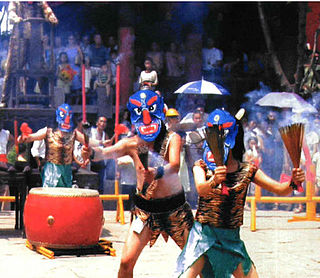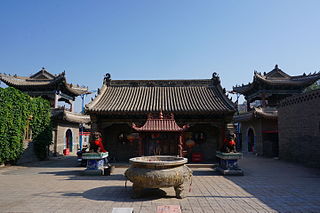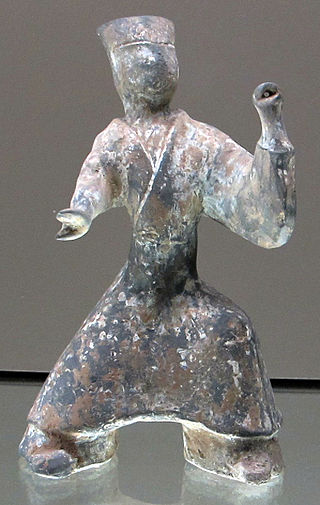
Taoism or Daoism is a diverse tradition indigenous to China, variously characterized as both a philosophy and a religion. Taoism emphasizes living in harmony with the Tao—generally understood as being the impersonal, enigmatic process of transformation ultimately underlying reality. The concept originates in the Chinese word 道, which has numerous related meanings: possible English translations include 'way', 'road', and 'technique'. Taoist thought has informed the development of various practices within the Taoist tradition and beyond, including forms of meditation, astrology, qigong, feng shui, and internal alchemy. A common goal of Taoist practice is self-cultivation resulting in a deeper appreciation of the Tao, and thus a more harmonious existence. There are different formulations of Taoist ethics, but there is generally emphasis on virtues such as effortless action, naturalness or spontaneity, simplicity, and the three treasures of compassion, frugality, and humility. Many Taoist terms lack simple definitions and have been translated in several different ways.

Religion in China is diverse and most Chinese people are either non-religious or practice a combination of Buddhism and Taoism with a Confucian worldview, which is collectively termed as Chinese folk religion.

Chinese folk religion, also known as Chinese popular religion, comprehends a range of traditional religious practices of Han Chinese, including the Chinese diaspora. Vivienne Wee described it as "an empty bowl, which can variously be filled with the contents of institutionalised religions such as Buddhism, Taoism, Confucianism and Chinese syncretic religions”. This includes the veneration of shen (spirits) and ancestors, exorcism of demonic forces, and a belief in the rational order of nature, balance in the universe and reality that can be influenced by human beings and their rulers, as well as spirits and deities. Worship is devoted to deities and immortals, who can be deities of places or natural phenomena, of human behaviour, or founders of family lineages. Stories of these gods are collected into the body of Chinese mythology. By the Song dynasty (960–1279), these practices had been blended with Buddhist, Confucianist doctrines and Taoist teachings to form the popular religious system which has lasted in many ways until the present day. The present day government of mainland China, like the imperial dynasties, tolerates popular religious organizations if they bolster social stability but suppresses or persecutes those that they fear would undermine it.
Taoist music is the ceremonial music of Taoism. The importance of music in Taoist ceremony is demonstrated by revealing how central beliefs are reflected through elements of music such as instrumentation and rhythm. Expression of spiritual beliefs through music enables followers of Taoism to enhance their path to enlightenment.

Buddhism's rich history spans over 2,500 years, originating from the Indian subcontinent in the 2nd century AD. Teachings of the Buddha were introduced over time, as a response to brahmanical teachings. Buddhism relies on the continual analysis of the self, rather than being defined by a ritualistic system, or singular set of beliefs. The intersections of Buddhism with other Eastern religions, such as Taoism, Shinto, Hinduism, and Bon illustrate the interconnected ideologies that interplay along the path of enlightenment. Buddhism and eastern religions tend to share the world-view that all sentient beings are subject to a cycle of rebirth that has no clear end.

Chinese temple architecture refer to a type of structures used as place of worship of Chinese Buddhism, Taoism or Chinese folk religion, where people revere ethnic Chinese gods and ancestors. They can be classified as:

Nuo opera or Nuo drama is one of China's most popular folk operas. Characterized by its special features such as ferocious masks, unique dresses and adornments, the strange language used in performance, and mysterious scenes, Nuo opera has been selected as one of the non-material cultural legacies of China. The opera is a religious performance intrinsic to the culture of Nuoism, a type of Chinese folk religion. The purpose of Nuo opera is to drive away devils, disease and evil influences, and also to petition for blessings from the gods. Singing and dancing are included in Nuo opera and performers wear costumes and masks.

Hòutǔ or Hòutǔshén, also Hòutǔ Niángniáng, otherwise called Dimǔ or Dimǔ Niángniáng, is the deity of all land and earth in Chinese religion and mythology. Houtu is the overlord of all the Tudigongs, Sheji, Shan Shen, City Gods, and landlord gods world wide.
Yao folk religion is the ethnic religion of the Yao people, a non-Sinitic ethnic group who reside in the Guangxi, Hunan and surrounding provinces of China. Their religion has been profoundly intermingled with Taoism since the 13th century, so much that it is frequently defined as Yao Taoism. In the 1980s it was found that the Yao clearly identified with the Chinese-language Taoist theological literature, seen as a prestigious statute of culture.

Chinese ritual mastery traditions, also referred to as ritual teachings, or Folk Taoism, or also Red Taoism, constitute a large group of Chinese orders of ritual officers who operate within the Chinese folk religion but outside the institutions of official Taoism. The "masters of rites", the fashi (法師), are also known in east China as hongtou daoshi (紅頭道士), meaning "redhead" or "redhat" daoshi, contrasting with the wutou daoshi (烏頭道士), "blackhead" or "blackhat" priests, of Zhengyi Taoism who were historically ordained by the Celestial Master.

Northeast China folk religion is the variety of Chinese folk religion of northeast China, characterised by distinctive cults original to Hebei and Shandong, transplanted and adapted by the Han Chinese settlers of Liaoning, Jilin and Heilongjiang since the Qing dynasty. It is characterised by terminology, deities and practices that are different from those of central and southern Chinese folk religion. Many of these patterns derive from the interaction of Han religion with Manchu shamanism.

Chinese folk religion plays a dynamic role in the lives of the overseas Chinese who have settled in the countries of this geographic region, particularly Burmese Chinese, Singaporean Chinese, Malaysian Chinese, Thai Chinese and Hoa. The Indonesian Chinese, by contrast, were forced to adopt en masse either Buddhism or Christianity in the 1950s and 1960s, abandoning traditional worship, due to Indonesia's religious policies which at the time forbade Chinese traditional religion or did not recognize it as a "religion" thus making it vulnerable to discrimination. Some Chinese Filipinos also still practice some Chinese traditional religions, besides Christianity of either Roman Catholicism or Protestantism, of which some have also varyingly syncretized traditional Chinese religious practices with. Chinese folk religion, the ethnic religion of Han Chinese, "Shenism" was especially coined referring to its Southeast Asian expression; another Southeast Asian name for the religion is the Sanskrit expression Satya Dharma.

The fangxiangshi was a Chinese ritual exorcist, the meaning of whose name is obscure but has been translated as "one who sees in all (four) directions", "he who scrutinizes for evil in many directions", and "one who orients unwanted spirits in the direction to which they belong". Ancient Chinese texts record that he wore a bearskin with four golden eyes, and carried a lance and shield to expel malevolent spirits. His primary duties were orchestrating the seasonal Nuo ritual to chase out disease-causing demons from houses and buildings, and leading a funeral procession to exorcize corpse-eating wangliang spirits away from a burial chamber. From the Han dynasty through the Tang dynasty, fangxiangshi were official wu-shaman specialists in the imperially sanctioned Chinese state religion; after the Tang, they were adapted into popular folk religion and symbolized by wearing a four-eyed mask.

Chinese gods and immortals are beings in various Chinese religions seen in a variety of ways and mythological contexts.

Chinese theology, which comes in different interpretations according to the classic texts and the common religion, and specifically Confucian, Taoist, and other philosophical formulations, is fundamentally monistic, that is to say it sees the world and the gods of its phenomena as an organic whole, or cosmos, which continuously emerges from a simple principle. This is expressed by the concept that "all things have one and the same principle". This principle is commonly referred to as Tiān 天, a concept generally translated as "Heaven", referring to the northern culmen and starry vault of the skies and its natural laws which regulate earthly phenomena and generate beings as their progenitors. Ancestors are therefore regarded as the equivalent of Heaven within human society, and therefore as the means connecting back to Heaven which is the "utmost ancestral father". Chinese theology may be also called Tiānxué 天學, a term already in use in the 17th and 18th centuries.
[In contrast to the God of Western religions who is above the space and time] the God of Fuxi, Xuanyuan, and Wang Yangming is under in our space and time. ... To Chinese thought, ancestor is creator.

The Wǔfāng Shàngdì, or simply Wǔdì or Wǔshén are, in Chinese canonical texts and common Chinese religion, the fivefold manifestation of the supreme God of Heaven. This theology dates back at least to the Shang dynasty. Described as the "five changeable faces of Heaven", they represent Heaven's cosmic activity which shapes worlds as tán 壇, "altars", imitating its order which is visible in the starry vault, the north celestial pole and its spinning constellations. The Five Deities themselves represent these constellations. In accordance with the Three Powers they have a celestial, a terrestrial and a chthonic form. The Han Chinese identify themselves as the descendants of the Red and Yellow Deities.

Wen Shen is a deity or group of deities responsible for illness, plague, and disease in Chinese folk religion. In some belief systems, Wen Shen is identified as a single entity who commands wen spirits; in others, the term is used for a grouping of several distinct deities.

Chinese New Year's Eve is the day before the Chinese New Year. Celebrating Chinese New Year's Eve has always been a family matter, it is the reunion day for every ethnic Chinese family. It has evolved over a long period of time. The origin of Chinese New Year's Eve can be traced back to 3500 years ago.

Chìdì or Chìshén, also known as the Nándì or Nányuèdàdì, as a human was Shénnóng, who is also the same as Yándì, a function occupied by different gods and god-kings in mytho-history. Shennong is also one of the Three Patrons, specifically the patron of humanity, and the point of intersection of the Three Patrons and Huangdi.




















